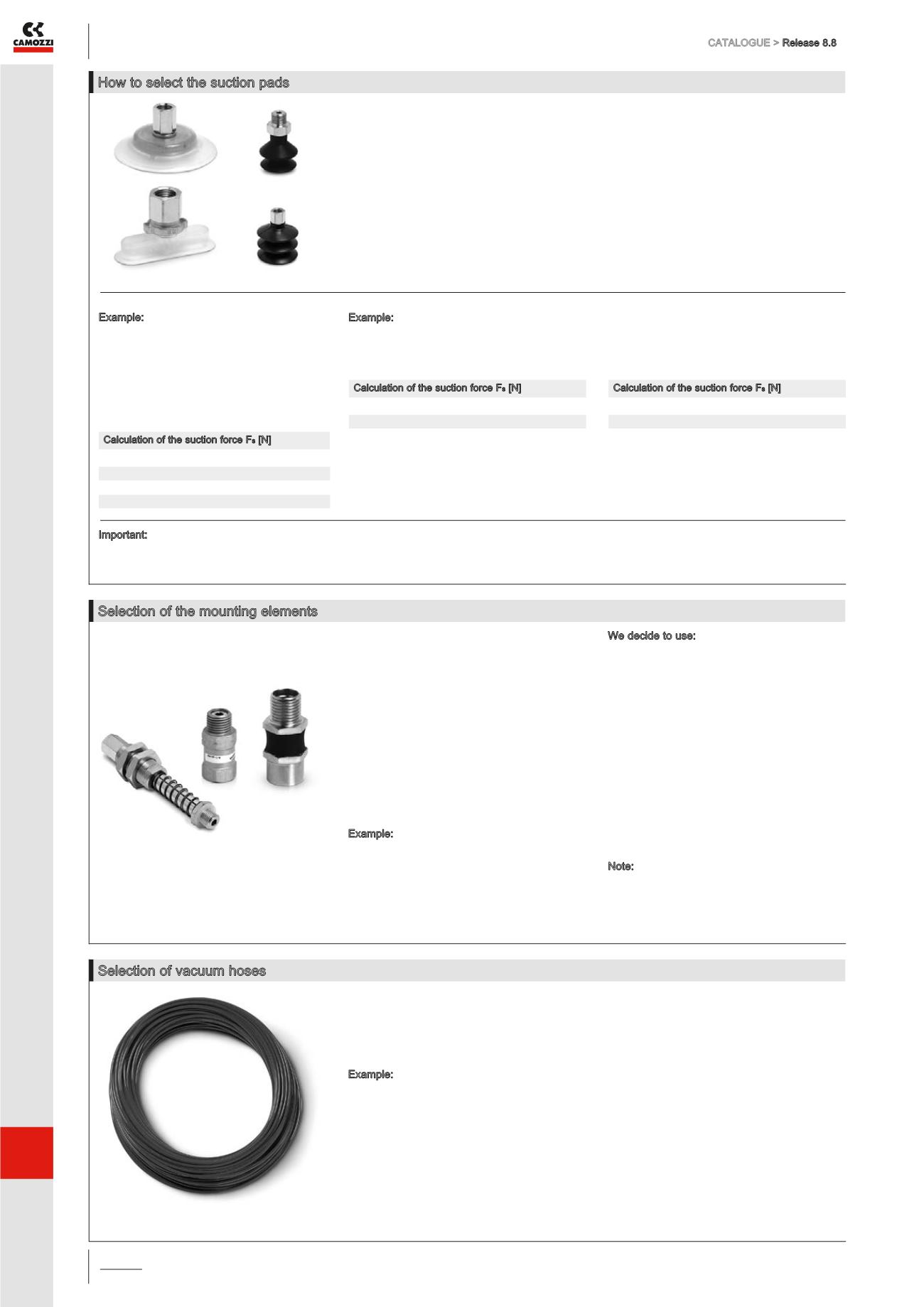

CATALOGUE >
Release 8.8
APPENDIX >
Technical information about products
How to select the suction pads
The suction pads are normally selected
on the basis of the following criteria:
Operating conditions: the operating conditions
(single or multiple shift operation, expected
lifetime, aggressive surroundings, temperature
etc.) at the point of use are decisive for the
selection of the suction pads.
For the selection of the vacuum pad material in
relation to the type of work piece to handle, see
the table shown in the end of the vacuum pad
section.
Surface: depending on the surface of the
handled workpieces, certain suction-pad
versions may be more suitable.
The product range includes flat and bellows
suction pads.
Example:
In this example, where steel sheets are to be
handled, we will use the flat suction pads,
Mod. VTCF in NBR.
This is the best and most efficient solution for
the handling of smooth, flat workpieces.
Example:
For medium sized (2500 x 1250 mm) steel sheets, normally 6 to 8 suction pads would be used.
The most important criterion for deciding the number of suction pads in this example, is the flexing
of the steel sheet during transport.
In this example we decide to use 6 pcs. of suction pads Mod. VTCF-950N since this number
is sufficient and helps to keep the costs down.
Important:
- The load which each suction pad can carry is shown in the table Technical Data.
- The load-carrying capacity of the suction pad must always be greater than the calculated value.
Selection of the mounting elements
Normally, the manner in which the suction pads
are mounted is defined to meet the customer’s
needs. However, there may be special reasons
which make a specific mounting element
mandatory in certain cases:
Uneven or sloping surfaces
The suction pad must be able to adapt itself
to the slope:
» flexible nipple NPF
Different heights or thicknesses
The suction pads must be spring-mounted in
order to compensate for varying heights:
» spring plunger NPM-NPR
Example:
In this example the steel sheets are stacked
on a pallet. If the sheets are larger than
the pallet, they may hang down at the ends.
This means that the suction pads must be able
to compensate for considerable height
differences and slope angles.
We decide to use:
Spring plunger NPM-FM-1/4-75
We need the largest possible stroke to cope
with the hanging ends of the steel sheets.
The 1/4 thread is needed for connection to the
flexible nipple.
Flexible nipple Mod. NPF
Optimum flexibility for inclined workpiece
surfaces.
Check valves Mod. VNV
These are used on vacuum gripper systems
containing multiple suction pads in order to shut
off indivual suction pads which are not covered
by the workpiece, (when handling work pieces
of different sizes).
Note:
When selecting the mounting elements, please
make sure that these can be screwed onto
the suction pads, i.e. that they have threads
of the same size. Also note the load-carrying
capacities of the mounting elements.
Selection of vacuum hoses
The size of the vacuum hose should match
the suction pads which are used.
For the selection of the suitable tube
dimensions, see recommendations under
Technical Data.
Example:
For exampe, from the table with Technical Data
we choose a TRN 8/6 hose in polyammide.
Calculation of the suction force F
S
[N]
F
S
= F
TH
/n
F
S
= suction force
F
TH
= theoretical force
n = number of suction pads
Calculation of the suction force F
S
[N]
F
S
= 1822/6
F
S
= 304 N
Calculation of the suction force F
S
[N]
F
S
= 1822/8
F
S
= 228 N
According to the Technical Data as shown on section
a/3.07_01 for Series VTCF, 6 pcs. of suction pads Mod.
VTCF-0950N are needed with a suction force of 340 N each.
According to the Technical Data as shown on section
a/3.07_01 for Series VTCF, 8 pcs. of suction pads Mod.
VTCF-800N are needed with a suction force of 260 N each.
a
APPENDIX
a
/3.06



















